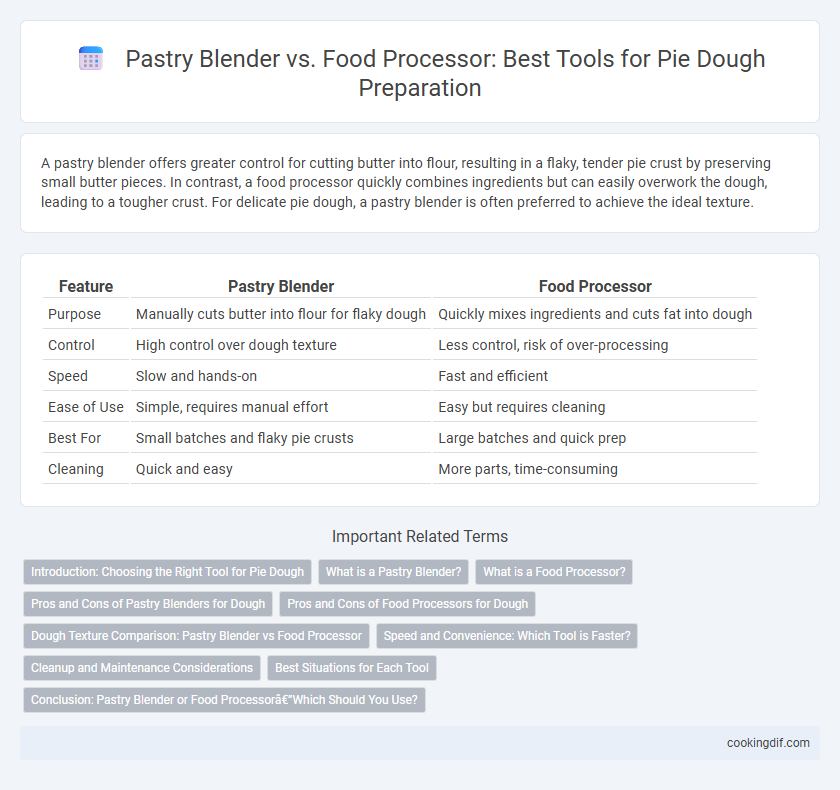A pastry blender offers greater control for cutting butter into flour, resulting in a flaky, tender pie crust by preserving small butter pieces. In contrast, a food processor quickly combines ingredients but can easily overwork the dough, leading to a tougher crust. For delicate pie dough, a pastry blender is often preferred to achieve the ideal texture.
Table of Comparison
| Feature | Pastry Blender | Food Processor |
|---|---|---|
| Purpose | Manually cuts butter into flour for flaky dough | Quickly mixes ingredients and cuts fat into dough |
| Control | High control over dough texture | Less control, risk of over-processing |
| Speed | Slow and hands-on | Fast and efficient |
| Ease of Use | Simple, requires manual effort | Easy but requires cleaning |
| Best For | Small batches and flaky pie crusts | Large batches and quick prep |
| Cleaning | Quick and easy | More parts, time-consuming |
Introduction: Choosing the Right Tool for Pie Dough
A pastry blender offers precise control for cutting butter into flour, ensuring a flaky pie crust by maintaining small, cold butter pieces. A food processor rapidly combines ingredients but risks overworking the dough, which can result in a tougher crust. Selecting the right tool depends on the desired dough texture and the baker's preference for manual versus mechanical mixing.
What is a Pastry Blender?
A pastry blender is a handheld kitchen tool specifically designed for cutting cold butter or shortening into flour to create a crumbly, flaky dough texture essential for pies and pastries. It typically features a handle with several thin, curved metal blades or wires that efficiently mix ingredients without overworking the dough. Unlike food processors, pastry blenders provide precise control to maintain dough temperature and texture, preventing the butter from melting prematurely.
What is a Food Processor?
A food processor is an electric kitchen appliance designed to quickly chop, slice, and mix ingredients, making it efficient for preparing pie dough. Its sharp blades and powerful motor can evenly incorporate fats into flour, reducing manual effort compared to a pastry blender. While food processors offer speed and versatility, controlling the dough's texture can be more challenging than the tactile precision you achieve with a pastry blender.
Pros and Cons of Pastry Blenders for Dough
Pastry blenders offer precise control over cutting butter into flour, resulting in a tender, flaky pie crust by preventing overworking the dough. Their simple design makes them easy to clean and ideal for small batches, though they require more manual effort and time compared to food processors. Unlike food processors, pastry blenders reduce the risk of overheating the butter, preserving the dough's optimal texture.
Pros and Cons of Food Processors for Dough
Food processors excel in quickly combining ingredients, producing consistent dough textures ideal for pie crusts. However, they can overwork the dough, leading to tougher crusts if not carefully monitored. Their powerful blades may also heat the dough, potentially affecting flakiness compared to gentler mixing methods like pastry blenders.
Dough Texture Comparison: Pastry Blender vs Food Processor
A pastry blender creates a coarser dough texture by manually cutting fat into flour, leading to flakier pie crusts with distinct layers. A food processor, while faster, tends to overwork the dough, producing a finer, more uniform consistency that can result in a denser crust. For optimal dough texture, a pastry blender offers greater control, preserving the desired crumbly structure essential for tender pie crusts.
Speed and Convenience: Which Tool is Faster?
A food processor blends dough significantly faster than a pastry blender, processing ingredients in seconds due to its powerful motor and sharp blades. A pastry blender requires manual effort and time, as it cuts fat into flour by hand, offering more control but less speed. For quick dough preparation, especially in larger batches, the food processor is the more convenient and efficient tool.
Cleanup and Maintenance Considerations
Pastry blenders require minimal cleanup with simple designs that are easy to wash by hand, ensuring no complex parts trap dough. Food processors involve more components like blades and bowls, necessitating thorough cleaning to avoid residue buildup and maintain blade sharpness. Choosing a pastry blender minimizes maintenance time, while food processors demand careful disassembly and cleaning to ensure long-term performance.
Best Situations for Each Tool
A pastry blender excels at cutting cold butter into flour for flaky pie crusts, offering precise control and minimal heat transfer that preserves dough texture. A food processor is ideal for quickly mixing larger batches of dough or incorporating ingredients uniformly, making it perfect for busy kitchens or when time is limited. Choosing the right tool depends on dough consistency needs and batch size, where the blender suits delicate, crumbly crusts, and the processor handles efficiency and volume.
Conclusion: Pastry Blender or Food Processor—Which Should You Use?
A pastry blender offers precise control for cutting butter into flour, ideal for flaky pie crusts, while a food processor excels in speed and uniform mixing, useful for larger batches. For delicate doughs requiring careful texture, a pastry blender is preferred; for quick preparation and consistent results, a food processor is more efficient. Choose based on dough type and desired crust quality to achieve optimal pie texture.
Pastry blender vs Food processor for dough Infographic

 cookingdif.com
cookingdif.com